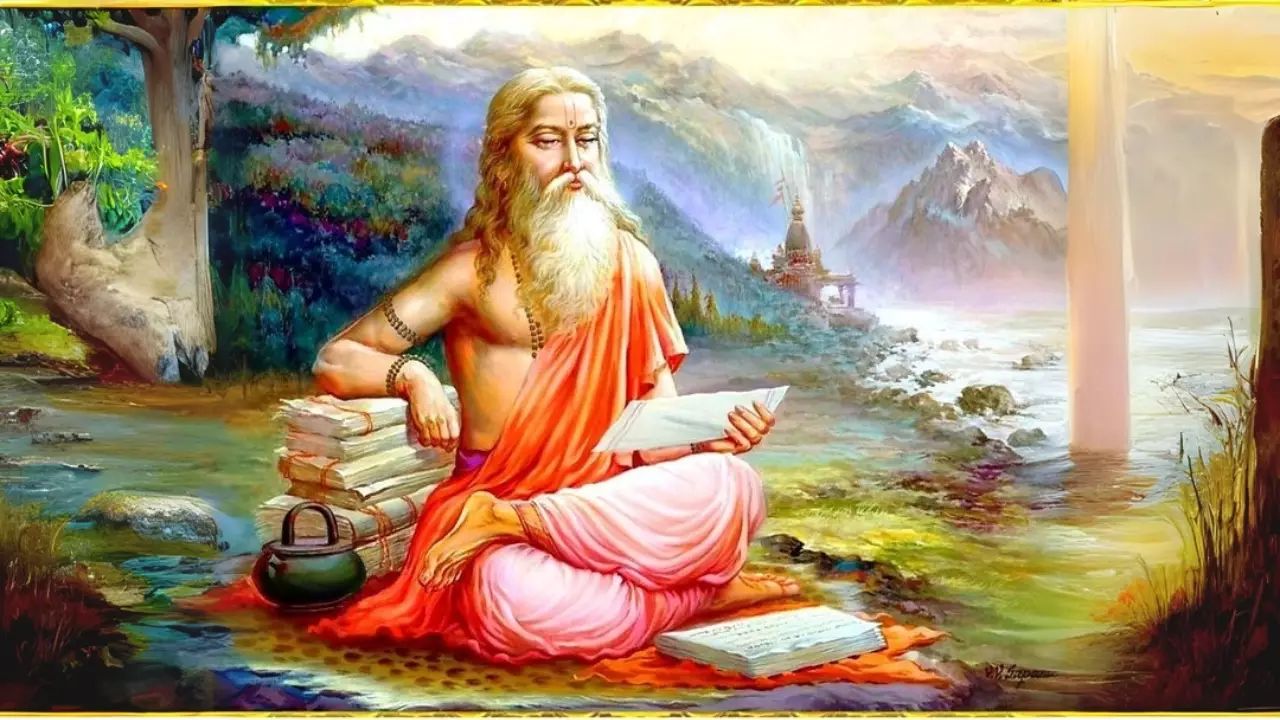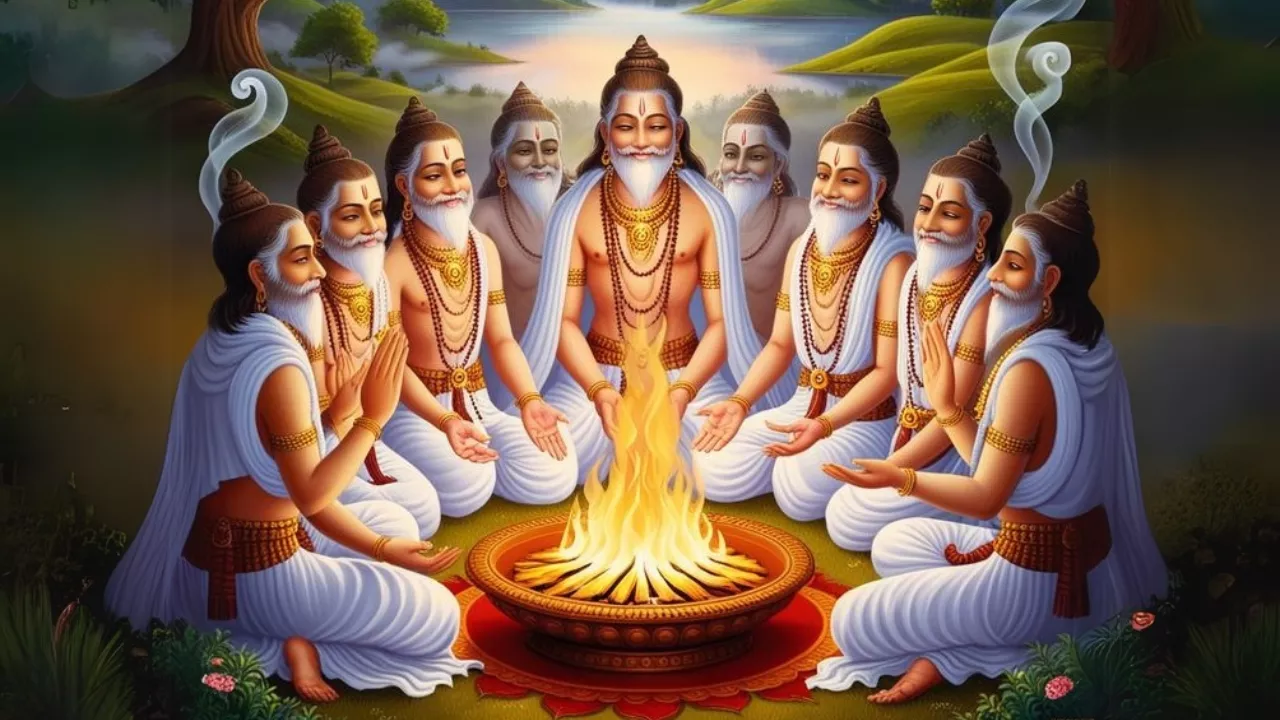Namaste,
The regional Pitrupaksha dates between the northern and southern parts of our sacred Bharat. It is indeed a pertinent question, as clarity in timing is essential for performing our duties with peace of mind and precision.
The perceived difference is not a contradiction in our scriptures, but rather a fascinating reflection of how the timeless wisdom of the cosmos, as revealed in our Purāṇas, is mapped onto the practical calendars used across our diverse land.
North vs. South India: Understanding the Variations in Regional Pitrupaksha Dates

At the heart of our discussion lies the sacred period itself – Pitrupaksha, the fortnight of the ancestors. Our most revered scriptures, like the encyclopedic Skanda Purāṇa and the insightful Garuḍa Purāṇa, are unanimous in identifying this period. They consistently describe it as the Kṛṣṇa Pakṣa (the dark, waning fortnight) of the lunar month generally identified as Bhādrapada. This is the foundational truth, the universal Puranic injunction that applies everywhere. This fortnight is universally acknowledged as the time when the veil between our world and the Pitṛ Loka (realm of ancestors) is thinnest, making our offerings and remembrances most potent.
So, if the Puranas define the period uniformly, why do we sometimes see different Gregorian calendar dates mentioned for Pitrupaksha in, say, Delhi compared to Chennai? The answer, lies not in a difference in the sacred period itself, but in the two primary ways our traditional lunar calendars (chandra māna) are reckoned across different regions.
The Dance of Sun and Moon: Understanding Lunar Calendars in Bharat

Before diving into the specifics, let us briefly understand our traditional timekeeping. Unlike the purely solar Gregorian calendar, our Hindu calendars are predominantly lunisolar. They track the phases of the Moon (for months and tithis) but also synchronize with the solar year (to ensure festivals align with seasons) through mechanisms like adding extra months (adhika māsa) periodically.
The key difference impacting regional Pitrupaksha dates arises from how a lunar month is defined – specifically, when it begins and ends. Two major systems prevail in Bharat:
- Pūrṇimānta Māna (Purnimanta System): Pūrṇimā + anta = ending on the Full Moon.
- Amāvasyānta Māna (Amanta System): Amāvasyā + anta = ending on the New Moon.
Both systems observe the same 30 tithis (lunar days) within a month, divided into the Śukla Pakṣa (bright, waxing fortnight) and the Kṛṣṇa Pakṣa (dark, waning fortnight). The difference lies purely in the starting and ending points.
The Purnimanta System: Prevalent in North India
- Geographical Spread: This system is widely followed in most of North India (including regions like Uttar Pradesh, Madhya Pradesh, Punjab, Haryana, Rajasthan, Bihar, etc.) and parts of Eastern and Western India.
- Month Definition: In the Purnimanta calendar, a lunar month begins the day after the Full Moon (Purnima) and ends on the next Full Moon (Purnima).
- Sequence: The month starts with the Krishna Paksha (dark fortnight, Tithis 1 to 15/Amavasya) and is followed by the Shukla Paksha (bright fortnight, Tithis 1 to 15/Purnima).
- Pitrupaksha Reckoning (Purnimanta):
- The month of Bhadrapada begins the day after Shravana Purnima (Raksha Bandhan).
- The first fortnight of the Purnimanta Bhadrapada month is its Krishna Paksha.
- Therefore, in North India and other regions following this system, Pitrupaksha starts immediately after Shravana Purnima and concludes on Bhadrapada Amavasya (which is Sarva Pitru Amavasya).
The Amanta (Amavasyanta) System: Prevalent in South India and Parts of West
- Geographical Spread: This system is the standard in most of South India (Tamil Nadu, Karnataka, Andhra Pradesh, Telangana) and also prevails in states like Maharashtra, Gujarat, and parts of Odisha and Bengal.
- Month Definition: In the Amanta calendar, a lunar month begins the day after the New Moon (Amavasya) and ends on the next New Moon (Amavasya).
- Sequence: The month starts with the Shukla Paksha (bright fortnight, Tithis 1 to 15/Purnima) and is followed by the Krishna Paksha (dark fortnight, Tithis 1 to 15/Amavasya).
- Pitrupaksha Reckoning (Amanta):
- The month of Bhadrapada begins the day after Shravana Amavasya.
- The first fortnight of the Amanta Bhadrapada month is its Shukla Paksha.
- The Krishna Paksha (dark fortnight) forms the second half of the Amanta Bhadrapada month.
- Therefore, in South India and other regions following this system, Pitrupaksha starts after Bhadrapada Purnima and concludes on Bhadrapada Amavasya (which is Sarva Pitru Amavasya).
Bridging the Gap: Why the Regional Pitrupaksha Dates Differ on the Gregorian Calendar
Now you see the crux of the matter,
- The 15-Day Shift: Because the Purnimanta system starts the month 15 days earlier (right after the previous month’s Purnima) compared to the Amanta system (which waits for the Amavasya), the entire month is shifted by half a month relative to each other.
- Same Krishna Paksha, Different Timing: Both systems agree that Pitrupaksha is the Krishna Paksha of Bhadrapada. However:
- In the Purnimanta calendar, this Krishna Paksha occurs in the first half of their Bhadrapada month.
- In the Amanta calendar, this same Krishna Paksha occurs in the second half of their Bhadrapada month (which corresponds to the first half of the next Purnimanta month, Ashwin).
- Resulting Gregorian Date Difference: This offset means that when you map these lunar fortnights onto the solar Gregorian calendar, the regional Pitrupaksha dates observed in North India will typically begin about 15 days earlier than those observed in South India.
Analogy: Imagine two friends reading the same sacred Purana. One decides to define “Chapter Bhadrapada” as starting from Verse 1 and ending at Verse 30. The other decides “Chapter Bhadrapada” starts at Verse 16 and ends at Verse 45 (carrying over into what the first friend calls the next chapter). Both agree that the crucial verses for Pitrupaksha are Verses 1-15 within the Puranic definition. Friend 1 reads them at the beginning of their “Chapter Bhadrapada”. Friend 2 reads the exact same verses, but they fall at the end of their “Chapter Bhadrapada”. The content (the sacred Krishna Paksha) is identical, but its placement within their respective chapter definitions differs.
So, when you see different Gregorian dates listed for Pitrupaksha starting, it’s simply reflecting which calendar system (Purnimanta or Amanta) is being used as the reference for mapping onto the solar calendar.
Unity in Diversity: Consistency in Pitrupaksha Significance and Rituals
Despite the difference in Gregorian start dates, the core essence, duration, and significance of Pitrupaksha remain universally consistent, drawing from the same Puranic wellspring.
- The Sacred Fortnight: It is always the 15-day period from the Pratipada (1st day) of the Krishna Paksha following the Bhadrapada Purnima, culminating in the Bhadrapada Amavasya. This specific sequence of tithis is what constitutes Pitrupaksha everywhere.
- Sarva Pitru Amavasya: The final day, the New Moon of Bhadrapada/Ashwin (depending on the system’s naming convention for the month containing this Amavasya), is universally recognized as Sarva Pitru Amavasya. Its paramount importance, as extolled by Skanda, Garuḍa, and Varāha Purāṇas, is acknowledged across all regions. It marks the simultaneous culmination of Pitrupaksha for everyone, regardless of their calendar’s starting point.
- Significant Tithis: The importance of specific tithis within the fortnight (like Chaturdashi for untimely deaths – Skanda, Agni Purāṇas; Navami for married women, etc.) is generally consistent. One performs the Shradhon the relevant tithi as it occurs sequentially within their observed Pitrupaksha period.
- Auspicious Timings (Muhurta): The ideal time of day for performing rituals, particularly the Kutapa Muhurta (midday) and the broader Aparahna Kala (afternoon) as highlighted in the Skanda Purāṇa, is a universal guideline based on the Sun’s position, not regional calendars.
- Potent Alignments: The significance of other auspicious times like Maha Bharani (Bharani Nakshatra during Pitrupaksha, linked to Yama), Vyatipata Yoga, eclipses, or Sankrantis (mentioned in Padma, Skanda, Varāha Purāṇas) is based on astronomical events and Puranic injunctions applicable everywhere.
The underlying Dharma, the rituals, the prayers, the intentions – these remain unified by the sacred texts. The difference in regional Pitrupaksha dates is purely a calendrical mapping variance.
Why Different Calendar Systems? A Glimpse into Tradition
Why did these two systems arise? Our Bharat is vast, and over millennia, different regions developed or adopted specific astronomical calculation methods and calendrical conventions based on local traditions, scholarly lineages (paramparās), and possibly astronomical observations. Both Purnimanta and Amanta systems are ancient and considered valid within the Vedic framework. They represent different, equally legitimate ways of structuring the lunar months while staying synchronized with the cosmos. Neither is inherently “more correct” than the other; they are simply different conventions that achieved widespread acceptance in different geographical areas.
Practical Guidance: Navigating the Regional Pitrupaksha Dates

So, how should you, navigate this?
- Follow Your Region/Family Tradition: The most important principle is to follow the Panchang and calendar system prevalent in your specific region or, even more importantly, the tradition followed by your family (kula paramparā). Your local temple priests will adhere to the regional calendar.
- Consult Local Panchangs: For accurate regional Pitrupaksha dates for any given year according to the Gregorian calendar, always consult a reliable Panchang specific to your area (North Indian Panchangs for Purnimanta dates, South Indian/Maharashtrian Panchangs for Amanta dates). Many online resources now specify which system they are using.
- Focus on the Tithis: Remember that the sequence of 15 tithis from Krishna Pratipada to Amavasya is Pitrupaksha. Even if the start date differs, the specific tithi for your ancestor’s Shradhwill occur within that sequence in your local calendar.
- Embrace the Unity: Understand that vaikka the Gregorian dates may differ by about two weeks, families across Bharat are observing the same sacred lunar fortnight dedicated to the Pitṛs, performing similar rituals based on the same Puranic guidance.
- Shradhis Paramount: Never let confusion over dates overshadow the true purpose. As the Padma Purāṇa reminds us, sincere devotion (bhakti) and faith (Shradh) are what truly please the ancestors. If you perform the rites according to your local tradition with a pure heart, your offerings will undoubtedly reach them.
Regional Pitrupaksha dates: Harmony in Diversity – The Spirit of Pitrupaksha Unites All
The perceived difference in regional Pitrupaksha dates is a beautiful example of Bharat’s underlying unity amidst its vibrant diversity. It stems not from conflicting doctrines but from different, equally valid ancient methods of mapping the sacred lunar rhythms onto our yearly calendar.
The Puranic foundation remains unshaken: Pitrupaksha is the Krishna Paksha of Bhadrapada, a fortnight of profound connection to our ancestors. Whether you begin observing it right after Shravana Purnima (as per Purnimanta system) or after Bhadrapada Purnima (as per Amanta system), you are partaking in the same sacred duty prescribed by our sages. The culmination on Sarva Pitru Amavasya unites all observances.
So, consult your local Panchang for the correct Gregorian dates applicable to you, follow your family traditions, and perform the Shradhrituals with unwavering faith and love. Know that across the land, countless others are doing the same during this consecrated time, bound together by the timeless love and respect we hold for those who came before us.
May your understanding be clear, your devotion deep, and may the blessings of your contented ancestors light your path always.
शुभमस्तु!
